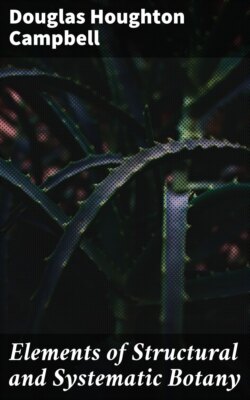Elements of Structural and Systematic Botany

Реклама. ООО «ЛитРес», ИНН: 7719571260.
Оглавление
Douglas Houghton Campbell. Elements of Structural and Systematic Botany
Elements of Structural and Systematic Botany
Table of Contents
PREFACE
BOTANY
CHAPTER I. INTRODUCTION
CHAPTER II. THE CELL
CHAPTER III. CLASSIFICATION OF PLANTS.—PROTOPHYTES
SUB-KINGDOM I. Protophytes
Class I.—The Slime Moulds
Class II.—Schizophytes
Class III.—Green Monads (Volvocineæ)
CHAPTER IV. SUB-KINGDOM II. Algæ.[3]
Class I.—Green Algæ
Order I.—Protococcaceæ
Order II.—Confervaceæ
CHAPTER V. Green Algæ—Continued
Order III.—Pond Scums (Conjugatæ)
Order IV.—Siphoneæ
Order V.—Characeæ
CHAPTER VI. THE BROWN ALGÆ (Phæophyceæ)
The True Brown Algæ
CHAPTER VII. Class III.—The Red Algæ (Rhodophyceæ)
CHAPTER VIII. SUB-KINGDOM III. Fungi
Class I.—Phycomycetes
Order II.—White Rusts and Mildews (Peronosporeæ)
Order III.—Saprolegniaceæ (Water Moulds)
CHAPTER IX. THE TRUE FUNGI (Mycomycetes)
Class I.—The Smuts (Ustillagineæ)
Class II.—Ascomycetes (Sac Fungi)
Order Lichenes
CHAPTER X. Fungi—Continued
Class Basidiomycetes
CHAPTER XI. SUB-KINGDOM IV. Bryophyta
Class I.—The Liverworts
Class II.—The True Mosses
Classification of the Mosses
CHAPTER XII. SUB-KINGDOM V. Pteridophytes
CHAPTER XIII. CLASSIFICATION OF THE PTERIDOPHYTES
Class I.—Ferns (Filicinæ)
Class II.—Horse-tails (Equisetinæ)
Class III.—The Club Mosses (Lycopodinæ)
CHAPTER XIV. SUB-KINGDOM VI. Spermaphytes: Phænogams
Class I.—Gymnosperms (Gymnospermæ)
Classification of the Gymnosperms
CHAPTER XV. SPERMAPHYTES
Class II.—Angiosperms
Classification of the Angiosperms
CHAPTER XVI. CLASSIFICATION OF THE MONOCOTYLEDONS
Order I.—Liliifloræ
Order II.—Enantioblastæ
Order III.—Spadicifloræ
Order IV.—Glumaceæ
Order V.—Scitamineæ
Order VI.—Gynandræ
Order VII.—Helobiæ
CHAPTER XVII. DICOTYLEDONS
CHAPTER XVIII. CLASSIFICATION OF DICOTYLEDONS
Division I.—Choripetalæ
CHAPTER XIX. CLASSIFICATION OF DICOTYLEDONS (Continued). Division II.—Sympetalæ
CHAPTER XX. FERTILIZATION OF FLOWERS
CHAPTER XXI. HISTOLOGICAL METHODS
FOOTNOTES
INDEX
NATURAL SCIENCE
Elements of Physics
Introduction to Physical Science
Introduction to Chemical Science
Laboratory Manual of General Chemistry
Young’s General Astronomy
Young’s Elements of Astronomy
Uranography
Plant Organization
A Primer of Botany
Outlines of Lessons in Botany
A Reader in Botany
Little Flower-People
Отрывок из книги
Douglas Houghton Campbell
For High Schools and Elementary College Courses
.....
On placing a cell into a fluid denser than the cell sap (e.g. a ten-per-cent solution of sugar in water), a portion of the water will be extracted from the cell, and we shall then see the protoplasm receding from the wall (Fig. 4, C), showing that it is normally in a state of tension due to pressure from within of the cell sap. The cell wall shows the same thing though in a less degree, owing to its being much more rigid than the protoplasmic lining. It is owing to the partial collapsing of the cells, consequent on loss of water, that plants wither when the supply of water is cut off.
As cells grow, new ones are formed in various ways. If the new cells remain together, cell aggregates, called tissues, are produced, and of these tissues are built up the various organs of the higher plants. The simplest tissues are rows of cells, such as form the hairs covering the surface of the organs of many flowering plants (Fig. 3), and are due to a division of the cells in a single direction. If the divisions take place in three planes, masses of cells, such as make up the stems, etc., of the higher plants, result (Fig. 4, A, B).
.....